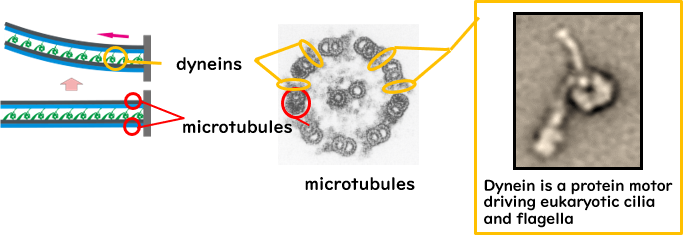ICT Application on the basis of intellect in nature Taking scientific lessons from the protein motors
IntroductionWe aim to understand the function of protein motors from a physical point of view. By using in vitro reconstitution system and single molecule measurement, we have greatly contributed to the progress of protein motor research. In in vitro reconstitution system, we reconstruct the functions of protein motors in vitro using the minimum components and measure their functions. In single molecule measurements, we capture only one molecule of protein motor and measure its mechanical and enzymatic properties. Furthermore, by combining structural analysis with functional measurements, we conduct integrative analyses covering from structure to function. We have published these findings in leading international science journals, including Nature. In addition, the importance of the research results was recognized, and in 2005, the 23rd Osaka Science Award was awarded. We also regard the protein motors as nanometer-scale functional materials and pursue interdisciplinary research aimed at engineering applications such as construction of active matter, bio-sensors, and ultra-compact actuators. These challenges lead to new development in the field of protein motor research. We are trying to create a new trend in ICT by proposing nobel concepts of information communication technology such as the molecular communication. |
Kazuhiro OIWA
|
The driving force underlying the movement of living things is the protein motor. In general, there are three types of protein motors; myosin, generating driving force of muscle contraction, kinesin being involved in the intracellular transport of various cargoes in cells, and dynein creating the bending movement of flagella and cilia. We have been focusing on the movement of flagella and cilia for more than 30 years, and have been working on their mechanism and functional analysis. We have developed techniques to directly measure the mechanical properties of flagella, and have developed an experimental system that physically measures movement and force using purified protein motors. At present, we have extended the research to understand the principle of collective movement of protein motors that spontaneously create various ordered structures, and we aim to artificially create flagellar structure and movement.

It moves by a flagellum |
 |
◆Protein motors are excellent molecular machines. It is possible to move uni-directionally with high efficiency even under the thermal fluctuation. |
The importance of dynein has increased in medical researches because its dysfunction results in various disease implications. The fragility of dynein has, however, hampered the progress of dynein researches.◆Dynein dysfunction causes a variety of diseases. In primary cilia dyskinesia (PCD) Ciliopathy, The incidence of the disease is estimated to be 1 in 16,000. ◆Understanding the function of dynein is a medically important issue. The number of the publication on flagella and cilia has increased by about 3 times since 2001. | ||
The elucidation of the principle of the protein motor provides a new guideline for the construction of molecular machines. | ||
NEWS
|
2020/1/20 I uploaded a dedicated website. |